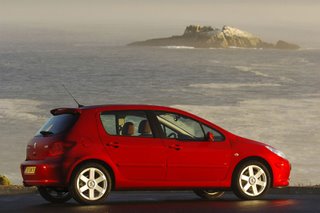Introduction (building on the success of the 307)
The Peugeot 307 was launched in 2001 and restyled (not dramatically) in 2005. It meant a great success for Peugeot being leader in several European markets, not only in France. It placed as a formidable rival for the Golf IV but also held its way very well against more recent cars like the Golf V and Renault Mégane II.
.
The Peugeot 307 has an interesting history. Initially designers at Peugeot generated two proposals: an improvement of the design of the Peugeot 306 (a more sleek and elegant vehicle), and something different. This different approach was inspired by the success of the first generation of the Renault Scénic. Designers at Peugeot went for this inspiration and designed a taller vehicle that looked almost like a monobox with the windscreen pushed forward. Eventually Peugeot PDG at the time (Jacques Calvet) gave an hesitant approval, only if his about-to-be successor (Folz), the engineering department and marketing department also approved. Everyone was happy with it so the forward thinking approach was chosen. A brave move by Peugeot considering the design practice at the time.
.
Eventually the Peugeot 307 proved a big success. It has many assets: a very good interior, strong on perceived quality, space, good diesel engines and Peugeots magic in the chassis/suspension. The best of all FWD compacts. Simultaneously agile, stable and comfortable. But its biggest feature was the design. Although a very tall car, designers managed to hide its height and made it look very imposing and sportive. One of the best road presences for compact cars, best observed when looking at it moving in the roads, next to other cars. It’s one of those cars that pictures don’t make it justice.
.
The success of this car could be a starting point for the attack of Peugeot to the first place in this segment. The way it proved strong as the competition was being renovated was a sign of it. Next we will see what Peugeot should do to make its successor, the Peugeot 308, the leader.
The Peugeot 307 was launched in 2001 and restyled (not dramatically) in 2005. It meant a great success for Peugeot being leader in several European markets, not only in France. It placed as a formidable rival for the Golf IV but also held its way very well against more recent cars like the Golf V and Renault Mégane II.
.
The Peugeot 307 has an interesting history. Initially designers at Peugeot generated two proposals: an improvement of the design of the Peugeot 306 (a more sleek and elegant vehicle), and something different. This different approach was inspired by the success of the first generation of the Renault Scénic. Designers at Peugeot went for this inspiration and designed a taller vehicle that looked almost like a monobox with the windscreen pushed forward. Eventually Peugeot PDG at the time (Jacques Calvet) gave an hesitant approval, only if his about-to-be successor (Folz), the engineering department and marketing department also approved. Everyone was happy with it so the forward thinking approach was chosen. A brave move by Peugeot considering the design practice at the time.
.
Eventually the Peugeot 307 proved a big success. It has many assets: a very good interior, strong on perceived quality, space, good diesel engines and Peugeots magic in the chassis/suspension. The best of all FWD compacts. Simultaneously agile, stable and comfortable. But its biggest feature was the design. Although a very tall car, designers managed to hide its height and made it look very imposing and sportive. One of the best road presences for compact cars, best observed when looking at it moving in the roads, next to other cars. It’s one of those cars that pictures don’t make it justice.
.
The success of this car could be a starting point for the attack of Peugeot to the first place in this segment. The way it proved strong as the competition was being renovated was a sign of it. Next we will see what Peugeot should do to make its successor, the Peugeot 308, the leader.




No comments:
Post a Comment